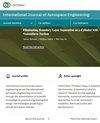Impact Analysis of Different Trajectory Shapes on Optimization Based on Original Natural Algorithm
IF 1.2
4区 工程技术
Q3 ENGINEERING, AEROSPACE
引用次数: 0
Abstract
In this paper, the reentry phase of the Aerospaceplane is taken as the research object, and the performance parameters of the reusable rocket of a private company are analyzed. Aiming at the guidance and control scheme of the spacecraft returning to the reentry trajectory in the real environment, the original natural algorithm is optimized by considering various reentry flight constraints, and the improved original natural algorithm is used to optimize the reentry trajectory of the Aerospaceplane. We obtained two types of reentry trajectories in the presence of large flight-restricted areas, the “S-type” trajectory and the “spiral-type” trajectory, and obtained data on various influencing factors. The results showed that the basic state parameters of the spiral trajectory optimized using the improved original natural algorithm after adding constraints met the constraint conditions. The aerodynamic heating rate and overload of the spiral reentry trajectory were to some extent greater than those of the S-type trajectory. Under the increasingly stringent requirements of the aerospace environment, new requirements were put forward for the thermal protection system to meet the wider environmental situation. This paper uses the improved original natural algorithm for the first time and applies it to the field of aerospace reentry and entry and adds more constraints to this algorithm for computation. Besides, for the first time, the macroscopic nature of trajectory types is used as a comparative element for parameter comparison, providing a reference basis for selecting trajectory optimization directions from the macroscopic perspective of trajectory types.基于原始自然算法的不同轨迹形状对优化的影响分析
本文以航天飞机返回阶段为研究对象,分析了某民营企业可重复使用火箭的性能参数。针对实际环境中航天器返回再入轨道的制导和控制方案,考虑各种再入飞行约束条件,对原始自然算法进行了优化,并利用改进后的原始自然算法对航天飞机的再入轨道进行了优化。我们得到了存在大面积飞行限制区域时的两种再入飞行轨迹,即 "S型 "轨迹和 "螺旋型 "轨迹,并获得了各种影响因素的数据。结果表明,在添加约束条件后,使用改进的原始自然算法优化的螺旋轨迹的基本状态参数满足约束条件。螺旋再入轨迹的气动加热率和过载在一定程度上大于 S 型轨迹。在航天环境要求日益严格的情况下,对热防护系统提出了新的要求,以适应更广泛的环境形势。本文首次使用了改进后的原始自然算法,并将其应用于航空航天再入大气层和进入大气层领域,同时为该算法增加了更多的计算约束条件。此外,还首次将轨迹类型的宏观性作为参数比较的比较要素,从轨迹类型的宏观角度为轨迹优化方向的选择提供了参考依据。
本文章由计算机程序翻译,如有差异,请以英文原文为准。
求助全文
约1分钟内获得全文
求助全文
来源期刊

International Journal of Aerospace Engineering
ENGINEERING, AEROSPACE-
CiteScore
2.70
自引率
7.10%
发文量
195
审稿时长
22 weeks
期刊介绍:
International Journal of Aerospace Engineering aims to serve the international aerospace engineering community through dissemination of scientific knowledge on practical engineering and design methodologies pertaining to aircraft and space vehicles.
Original unpublished manuscripts are solicited on all areas of aerospace engineering including but not limited to:
-Mechanics of materials and structures-
Aerodynamics and fluid mechanics-
Dynamics and control-
Aeroacoustics-
Aeroelasticity-
Propulsion and combustion-
Avionics and systems-
Flight simulation and mechanics-
Unmanned air vehicles (UAVs).
Review articles on any of the above topics are also welcome.
 求助内容:
求助内容: 应助结果提醒方式:
应助结果提醒方式:


